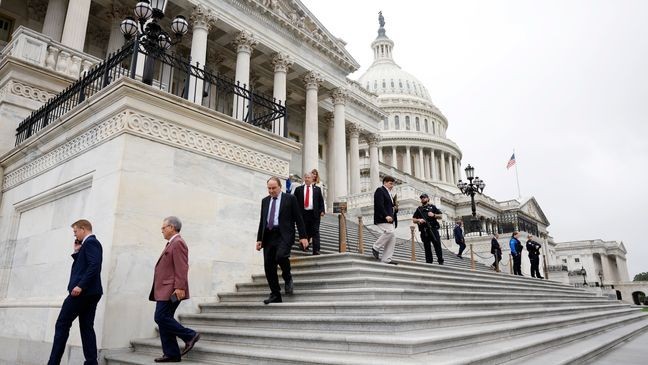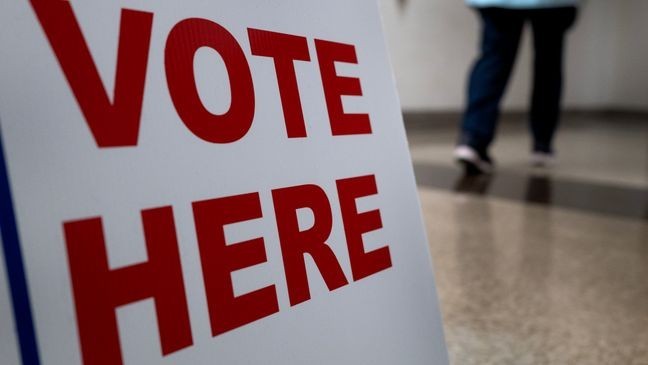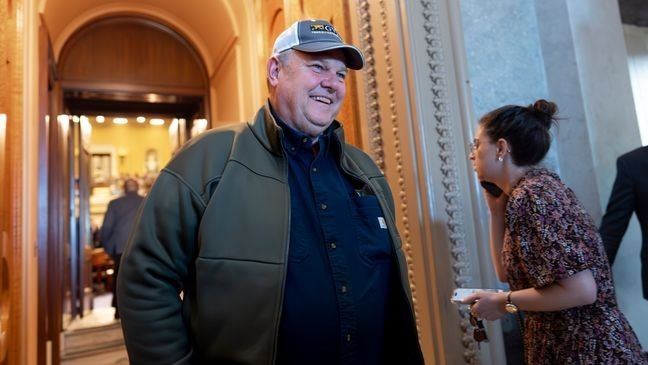GOP in good position to gain control of Senate; House true toss-up
(TNND) — With a week to go until Election Day, Democrats are looking at a tough map to retain control of the Senate.
The House of Representatives is more of a true toss-up, as is the White House.
Democrats effectively hold a 51-49 advantage now in the Senate, including independents who caucus with Democrats and the tiebreaker if needed from the vice president.
That chamber of Congress is likely to flip, said Casey Burgat, the Legislative Affairs Program Director at George Washington University.
Burgat said political forecasters are more confident in the fate of the Senate than they are in the House or the presidential race.
Democrats have too many vulnerable seats to defend and don’t have the opportunities to gain substitute seats.
“Just the map was always so hard” for Democrats, Burgat said.
Democratic Sen. Jon Tester is trying to win in deep-red Montana, which Burgat said is looking increasingly difficult. Tester's Republican challenger isTim Sheehy, a formerNavy SEAL.
Democrats face tough toss-up Senate races in Michigan, Ohio, Pennsylvania and Wisconsin.
“We'll see what the trickle-down looks like from the presidential (race). Those are all swing states, huge swing states, outside of (Ohio Sen.) Sherrod Brown,” Burgat said. “And then you even throw in Arizona being an open seat. Who knows what will happen there. And then Nevada, they're all going to be tied to the presidential coattails.”
There are seven battleground states in the presidential race, including Arizona and Nevada.
If voters in Nevada turn out for former President Donald Trump, what will that mean for Democratic incumbent Sen. Jacky Rosen?
Arizona Sen. Kyrsten Sinema, who became an independent who caucuses with Democrats, isn’t seeking reelection.
GOP candidate Kari Lake is facing off against Democratic Rep. Ruben Gallego to fill the Senate seat from Arizona.
There’s been a decline in split-ticket voting over the years, but Ohio, Nevada and Arizona are all places we could see voters go one direction for president and the other direction for Senate.
For example, a new Marist poll showed Trump with a 50% to 49% edge over Vice President Kamala Harris among likely Arizona voters.
But the same poll showed Gallego, the Democratic candidate for Senate, with an eight-point lead over Lake.
Tester has held his Senate seat from Montana since 2007, even though his state has voted for the Republican presidential candidate in every election since the mid-1990s.
Brown, also a Democrat, has served in the Senate since 2007. Meanwhile, his state, Ohio, has went into Trump’s column in the last two presidential elections.
There are 34 Senate seats up for grabs this election, along with all House seats.
Democrats have 23 Senate seats to defend to 11 seats for the Republicans.
Tammy Baldwin and Bob Casey Jr. are fairly popular incumbents in traditionally blue states – Wisconsin and Pennsylvania – but those are also swing states in which they could lose if voters turn out for Trump.
Charles Hunt, a politics professor at Boise State University who focuses on Congress, said Montana looks like it might be slipping away for Democrats.
But Democrats might benefit in Nebraska with an independent candidate, Dan Osborn, challenging Republican Sen. Deb Fischer. That one's looking really competitive, Hunt said.
“And, of course, the usual pipe dream of Texas, which does look like it might be at least as close as (Sen. Ted ) Cruz's 2018 race against Beto O'Rourke,” Hunt said via email. “I would be surprised but not shocked if that went (the Democrats’) way."
Democratic Rep.Colin Allred is challenging Cruz for his Senate seat in Texas.
Republicans currently have control of the House, 220 seats to 212 for the Democrats. There are also three vacancies.
Burgat said the House might be the more interesting chamber this election, because it’s far less predictable than the Senate.
“I do think it's a genuine toss-up,” Burgat said. “I mean, it was already razor-thin going into the election.”
The Cook Political Report has 25 toss-up districts in the House, 12 more leaning Democratic, and six more leaning Republican.
Burgat said there are a historically small number of toss-ups this year in the House.
Democratic Rep. Abigail Spanberger in Virginia is running for governor, and Burgat said that’s going to be a tough House seat for Democrats to defend.
Democrats in competitive House districts have to overcome an unpopular Democratic administration and the desire for change.
Republicans in competitive House districts have to overcome the potential distaste moderate voters have for Trump and the MAGA movement.
Burgat said conventional wisdom is “that these are the folks that should be, or at least historically would be, distancing themselves from a polarizing figure to their moderate voters. But a lot of these folks are taking the other route, but more doubling down that the Trump popularity, particularly with the base voters, they will bring enough of them out that they don't need to appeal anymore to the shrinking independent voters. So, we'll see if that strategy bears out.”
But the most interesting House races will be in the big states of California and New York, he said.
There are 12 seats between those two states – seven in California and five in New York – that fall into a toss-up or leaning category.
“Those are countries by themselves. So, we paint California and New York as already decided. And they are, but only at the presidential level,” Burgat said. “But they really have every type of demographic, every type of constituency. And some of these districts are incredibly rural and conservative, even in liberal states.”




